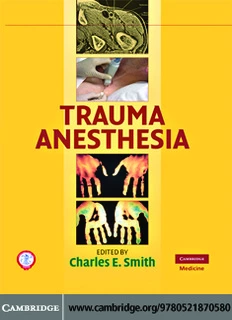
trauma anesthesia PDF
Preview trauma anesthesia
P1:OSO/OVY P2:OSO/OVY QC:OSO/OVY T1:OSO Printer:YetToCome CUFX276-FM CUFX276-Smith-v2 June11,2008 22:55 This page intentionally left blank ii P1:OSO/OVY P2:OSO/OVY QC:OSO/OVY T1:OSO Printer:YetToCome CUFX276-FM CUFX276-Smith-v2 June11,2008 22:55 T A R A U M A N E S T H E S I A Injuriesareestimatedtobecomethenumber-onecauseofdeathformenand womenundertheageof45bytheyear2020.Traumapatientspresentunique challengestoanesthesiologists.Acuteinjuriesrequireresource-intensivecare andareoftencomplexcases,especiallywhencoupledwithunderlying,pre- existing medical conditions. Anesthesiologists are involved with trauma patientsbeginningwithairwayandshockresuscitation,continuingwithintra- operativecareduringsurgery,andextendingontopainmanagementandcrit- icalcarepostoperatively.Thisnewreferencefocusesonabroadspectrumof traumaticinjuriesandtheproceduresanesthesiologistsperformtoadequately carefortraumapatientsperioperatively,surgically,andpostoperatively.Spe- cialemphasisisgiventotheassessmentandtreatmentofcoexistingdisease. Numerous tables and more than 300 illustrations showcasing various tech- niquesofairwaymanagement,shockresuscitation,echocardiography,anduse ofultrasoundfortheperformanceofregionalanesthesiaintraumaprovide aninvaluablereferencefortheanesthesiologist. Dr. Charles E. Smith is board-certified in anesthesiology and in periopera- tivetransesophagealechocardiography,hasexpertiseintraumacare,andhas publishedextensivelyontopicsintraumaanesthesia. i P1:OSO/OVY P2:OSO/OVY QC:OSO/OVY T1:OSO Printer:YetToCome CUFX276-FM CUFX276-Smith-v2 June11,2008 22:55 ii P1:OSO/OVY P2:OSO/OVY QC:OSO/OVY T1:OSO Printer:YetToCome CUFX276-FM CUFX276-Smith-v2 June11,2008 22:55 T A R AU MA N E S T H E S IA Edited by C E. S HARLES MITH MetroHealthMedicalCenter Associate Editor J J. C OHN OMO MetroHealthMedicalCenter iii CAMBRIDGEUNIVERSITY PRESS Cambridge, New York, Melbourne, Madrid, Cape Town, Singapore, São Paulo Cambridge University Press The Edinburgh Building, Cambridge CB2 8RU, UK Published in the United States of America by Cambridge University Press, New York www.cambridge.org Information on this title: www.cambridge.org/9780521870580 © Charles E. Smith 2008 This publication is in copyright. Subject to statutory exception and to the provision of relevant collective licensing agreements, no reproduction of any part may take place without the written permission of Cambridge University Press. First published in print format 2008 ISBN-13 978-0-511-41388-9 eBook (EBL) ISBN-13 978-0-521-87058-0 hardback Cambridge University Press has no responsibility for the persistence or accuracy of urls for external or third-party internet websites referred to in this publication, and does not guarantee that any content on such websites is, or will remain, accurate or appropriate. Every effort has been made in preparing this publication to provide accurate and up-to- date information that is in accord with accepted standards and practice at the time of publication. Nevertheless, the authors, editors, and publisher can make no warranties that the information contained herein is totally free from error, not least because clinical standards are constantly changing through research and regulation. The authors, editors, and publisher therefore disclaim all liability for direct or consequential damages resulting from the use of material contained in this publication. Readers are strongly advised to pay careful attention to information provided by the manufacturer of any drugs or equipment that they plan to use. P1:OSO/OVY P2:OSO/OVY QC:OSO/OVY T1:OSO Printer:YetToCome CUFX276-FM CUFX276-Smith-v2 June11,2008 22:55 C ONTENTS page vii Foreword:AdolphH.(Buddy)Giesecke,MD[Anesthesia] Foreword:MarkA.Malangoni,MD[Surgery] ix Preface xi Acknowledgments xiii Contributors xv 1. MechanismsandDemographicsinTrauma 1 PedroBarbieri,DanielH.Gomez,PeterF.Mahoney,PabloPratesi,and ChristopherM.Grande 2. TraumaAirwayManagement 9 WilliamC.Wilson 3. ShockManagement 55 RichardP.Dutton 4. EstablishingVascularAccessintheTraumaPatient 69 MatthewA.Joy,DonnMarciniak,andKasiaPetelenz-Rubin 5. MonitoringtheTraumaPatient 81 ElizabethA.Steele,P.DavidSøran,DonnMarciniak,andCharlesE.Smith 6. FluidandBloodTherapyinTrauma 101 MaximNovikov,andCharlesE.Smith 7. MassiveTransfusionProtocolsinTraumaCare 121 JohnE.Forestner 8. BloodLoss:DoesItChangeMyIntravenousAnesthetic? 133 KenJohnson,andTalmageD.Egan 9. PharmacologyofNeuromuscularBlockingAgentsandTheirReversal inTraumaPatients 142 Fran¸coisDonati 10. AnesthesiaConsiderationsforAbdominalTrauma 155 WilliamC.Wilson 11. HeadTrauma–AnesthesiaConsiderationsandManagement 172 PaulTenenbein,M.SeanKincaid,andArthurM.Lam 12. IntensiveCareUnitManagementofPediatricBrainInjury 187 RobertCohn,MarounJ.Mhanna,ElieRizkala,andDennisM.Super 13. SurgicalConsiderationsforSpinalCordTrauma 202 TimothyMoore 14. AnesthesiaforSpinalCordTrauma 213 M.SeanKincaid,andArthurM.Lam 15. MusculoskeletalTrauma 225 HeatherA.Vallier,andMarkD.Jenkins v P1:OSO/OVY P2:OSO/OVY QC:OSO/OVY T1:OSO Printer:YetToCome CUFX276-FM CUFX276-Smith-v2 June11,2008 22:55 vi ■ CONTENTS 16. AnestheticConsiderationsforOrthopedicTrauma 245 RobertM.Donatiello,AndrewD.Rosenberg,andCharlesE.Smith 17. CardiacandGreatVesselTrauma 260 NazBigeAydin,MichaelC.Moon,andInderjitGill 18. AnesthesiaConsiderationsforCardiothoracicTrauma 279 MarkA.GerhardtandGlennP.Gravlee 19. IntraoperativeOne-LungVentilationforTraumaAnesthesia 300 GeorgeW.KanellakosandPeterSlinger 20. BurnInjuries(CriticalCareinSevereBurnInjury) 314 CharlesJ.Yowler 21. AnesthesiaforBurns 322 JessicaAnneLovich-Sapola 22. FieldAnesthesiaandMilitaryInjury 343 PeterF.MahoneyandCraigC.McFarland 23. EyeTraumaandAnesthesia 360 MartinDauberandStevenRoth 24. PediatricTraumaandAnesthesia 367 JocelynLoy 25. TraumaintheElderly 391 JeffreyH.Silverstein 26. TraumainPregnancy 402 JohnR.Fisgus,KalpanaTyagaraj,andSohailKamranMahboobi 27. OralandMaxillofacialTrauma 417 KetanP.ParekhandCecilS.Ash 28. DamageControlinSevereTrauma 431 MichaelJ.A.ParrandUlrikeBuehner 29. HypothermiainTrauma 445 EldarSøreideandCharlesE.Smith 30. ITACCSManagementofMechanicalVentilationinCriticallyInjuredPatients 465 MaureenMcCunn,AnneJ.Sutcliffe,WalterMauritz,andtheInternationalTrauma AnesthesiaandCriticalCareSociety(ITACCS)CriticalCareCommittee 31. TraumaandRegionalAnesthesia 471 ShaliniDhirandSuganthaGanapathy 32. UltrasoundProceduresinTrauma 499 PaulSoedingandPeterHebbard 33. UseofEchocardiographyandUltrasoundinTrauma 514 ColinRoyseandAlistairRoyse 34. PharmacologicManagementofAcutePaininTrauma 528 ShaliniDhir,VeerabadranVelayutham,andSuganthaGanapathy 35. PosttraumaChronicPain 544 DavidRyanandKutaibbaTabbaa 36. TraumaSystems,Triage,andTransfer 569 JohnJ.Como 37. Teams,TeamTraining,andtheRoleofSimulationinTraumaTraining andManagement 579 PaulBarach Index 591 Colorplatesfollowpage 294 P1:OSO/OVY P2:OSO/OVY QC:OSO/OVY T1:OSO Printer:YetToCome CUFX276-FM CUFX276-Smith-v2 June11,2008 22:55 F OREWORD Dr.CharlesE.Smithhasbeeninspiringimprovedanesthesiafor traumatized patient. This book discusses the established and thevictimsoftraumaticinjuryformanyyears,havingspentthe the controversial concepts. Also discussed is a new protocol- majorityofhiscareeratMetroHealthMedicalCenter,Cleve- driven,multidisciplinaryapproachtomassivetransfusion.This land, Ohio, which is the city’s major trauma center. He has approach,whichrequirescooperationbetweenthebloodbank, regularlyservedaslecturerinrefreshercoursesfortheInterna- thetraumasurgeons,andanesthesiologists,takestheguesswork tionalTraumaAnesthesiaandCriticalCareSociety(nowcalled outofmassivetransfusion.Nolongerdowehavetostandat InternationalTraumaCare).Heisaproductiveauthorofinno- the OR table and ponder, “Is it time for platelets and fresh vative research in the care of the traumatized patient. These frozenplasma?”Thesecollaborativedecisionshavebeenmade attributes easily qualify him to be editor of a multi-authored in advance, and all we have to do is to activate the proto- comprehensivebookontraumaanesthesia,towhichheisalso col and administer whatever comes in the incremental allot- amajorcontributor.Hisinvitedchapterauthorsaresimilarly ments. qualified. The result is an authoritative, readable, and educa- Patientsnowexpecttoberelievedofsignificantpain,and tionalresourceforthestudent,resident,orpractitionerwishing painisconsideredthefifthvitalsign.Significantadvanceshave tostayabreastofarapidlychangingfield. beenmadeinthetechniquesforreliefofacutetraumaticand Epochalchangeshaveoccurredinthepracticeofanesthesi- postoperativepain.Entireteamsofpeoplearenowdedicated ologyinthelasttenyears.Improvedmonitors,saferdrugs,and tothispractice.Nobodyquestionsthevalueofpainrelief,but better-trained anesthesiologists, nurse anesthetists, and anes- it comes with some risk. A multimodal approach appears to thesia assistants have all reduced the morbidity and mortal- accomplishthegoalandsimultaneouslyminimizetherisks. ity of anesthesia. Anesthesia has become safer. Safer anesthe- Thermal injuries, brain injuries, and spinal cord injuries sia improves the outcome of traumatic injuries. Our surgical arespecializedformsoftraumathatareoccasionallyneglected. colleagues have contributed to the improvements in trauma Notsointhistext.Thepublichealthimplicationsarepresented care.Innovationsinthecareofseriousfractures,useofdam- along with the practical considerations for safe clinical man- agecontrolinabdominalinjuries,andimprovedcareofburns agement.Thepracticalconsiderationsareimportantbecause, havereducedmorbidityandmortality.Dr.Smithhasincluded for example, drugs and procedures that may be beneficial in allofthelatestinnovationsinthistext.Despitetheadvances, themanagementoforthopedicinjuriesarecontraindicatedin theimportanceoftraumaasacauseofdisabilityandlostlife neurologic injuries. We must be able to recognize these con- remainsand,infact,whenexpressedasaproportiontooverall flictswhentheyoccurtogetherinthesamepatientandcreate mortalityinyoungpeople,isincreasinginimportance. ananestheticplanthatwillbenefitthepatient. Throughout history significant advances have been made Dr. Smith and his invited authors have done a magnifi- in anesthetic care during times of war. The war in Iraq is no cent job of pulling together the diverse concepts of the man- exception,andthelessonslearnedinthatconflictareincluded. agement of the traumatized patient and presenting us with a Thetechnologyofvascularaccesshasgreatlyimproved.Ultra- valuableresourcefortheanesthesiologist.Althoughdirectedat sonic localization of major veins for central access is a major theanesthesiologist,thetextisusefulforemergencymedicine advance greatly enhancing safety for the patient. The tech- physicians,surgeons,orthopedists,and,infact,anyhealthcare nique of intraosseous infusion was once painful and cum- professional who deals with trauma. Congratulations to the bersome to establish, such that it was considered a circus entiregroupofauthors! stuntandnotofmuchpracticalvalue.Newlydesignedequip- ment has revolutionized the technique. It is now fast, pain- AdolphH.(Buddy)GieseckeMD,EmeritusProfessor less, convenient, and effective in any patient with difficult IV AnesthesiologyandPainManagement access.Havingestablishedvascularaccess,thechoiceandvol- UniversityofTexasSouthwesternMedicalCenter umeoffluidtherapyiscriticaltosurvivalandoutcomeofthe Dallas,Texas vii P1:OSO/OVY P2:OSO/OVY QC:OSO/OVY T1:OSO Printer:YetToCome CUFX276-FM CUFX276-Smith-v2 June11,2008 22:55 viii
Description: